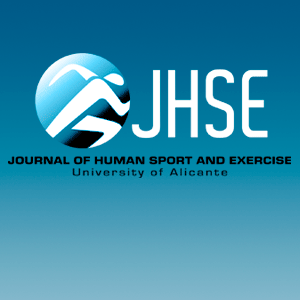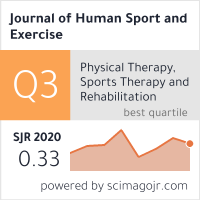Kicking ability in pencak silat, reviewed from eye-foot coordination, speed, and ratio of limb length-body height
Keywords:
Pencak silat kicks, Eye-foot coordination, Speed, Ratio of limb length-body heightAbstract
The purpose of this study is to determine the correlation between eye-foot coordination (both single and double), speed, and limb length-body height ratio with the ability to perform (sickle) kicks in pencak silat and how much the contribution of each of these attributes. Correlation study was performed with data collection techniques through performance evaluation tests on each variable. 30 male athletes of Pencak Silat Club of Universitas Muhammadiyah Surakarta (UMS) with height criteria (163-165cm) were willing to participate in this study. The results showed that each variable had a significant correlation, both single and double. Eye-foot coordination and speed have a significant correlation with kicking ability in pencak silat, both with or without controlling other supporting variables. While the ratio of limb length to body height has a correlation with kicking ability if influenced by eye-foot coordination and speed. Eye-foot coordination makes a relative contribution (52.17%), effective (35.11%), speed makes a relative contribution (35.75%), effective (24.06%), and the ratio of limb length to body height makes a relative contribution (12.02%), effective (8.09%). The total effective contribution of the independent variables to the dependent variables is 67.26%. Thus, to improve the ability to perform kicks in pencak silat, an athlete should be able to take advantage of eye-foot coordination and to exert speed by contributing a good ratio of limb length-body height according to the demands of pencak silat.
Downloads
References
Alexander, B. and Vladislav, B. (2016) ‘Factors that determine high efficiency in developing speed and strength abilities of female hurdlers’, Journal of Physical Education & Sport, 16(3), pp. 910–913.
Alexander, B. and Vladislav, B. (2018) ‘Pedagogical practice for development of coordination potential of MMA fighters and estimation of its efficiency’, Journal of Human Sport and Exercise, 13(1), pp. 72–88. https://doi.org/10.14198/jhse.2018.131.08
Aziz, A. R., Benedict, T. and Teh, K. C. (2002) ‘Physiological responses during matches and profile of elite pencak silat exponents’, Journal of Sports Science & Medicine, 1(4), pp. 147–155.
Hariono, A., Rahayu, T. and Sugiharto (2017) ‘Developing a performance assessment of kicks in the competition category of pencak silat martial arts’, The Journal of Educational Development, 5(2), pp. 224–237.
Iswana, B. and Siswantoyo, S. (2013) ‘Model latihan keterampilan gerak pencak silat anak usia 9-12 tahun’, Jurnal Keolahragaan, 1(1), pp. 26–26. https://doi.org/10.21831/jk.v1i1.2343
James, L. P., Haff, G.G., Kelly, V.G., and Beckman, E.M.. (2016) ‘Towards a determination of the physiological characteristics distinguishing successful mixed martial arts athletes: a systematic review of combat sport literature’, Sports Medicine, 46(10), pp. 1525–1551. https://doi.org/10.1007/s40279-016-0493-1
Kostikiadis, I. N., Methenitis, S., Tsoukos, A., Veligekas, P., Terzis, G., and Bogdanis, G.C. (2018) ‘The effect of short-term sport-specific strength and conditioning training on physical fitness of well-trained mixed martial arts athletes’, Journal of Sports Science & Medicine, 17(3), pp. 348–358.
Lariosa, C. J. D., Gozdowski, D., Pietkiewicz, S., and Maciejewski, R. (2017) ‘Survey of judo injuries in physical education classes: a retrospective analysis’, Journal of Physical Education and Sport, 17(3), pp. 2034–2042.
Lenetsky, S. and Harris, N. (2012) ‘The mixed martial arts athlete: a physiological profile’, Strength & Conditioning, 34(1), pp. 32–47. https://doi.org/10.1519/ssc.0b013e3182389f00
Murzinova, K. E. A., Koblanova, A., & Ansabayeva, D. A. A. (2018). Prosodical means applied in communicative relations. Opción, 34(85-2), 61-96.
Myers, T., Nevill, A. and Al Nakeeb, Y. (2013) ‘A comparison of the effect of two different judging systems on the technique selection of Muay Thai competitors’, Journal of Human Sport and Exercise, 8(3), pp. 761–777. https://doi.org/10.4100/jhse.2013.83.01
Nugroho, A. (2004) Dasar-dasar Pencak Silat. Yogyakarta: Universitas Negeri Yogyakarta.
Puspitasari, L., In'am, A., & Syaifuddin, M. (2019). Analysis of Students’ Creative Thinking in Solving Arithmetic Problems. International Electronic Journal of Mathematics Education, 14(1), 49-60. https://doi.org/10.12973/iejme/3962
Sajoto, M. (1988) Pembinaan Kondisi Fisik dalam Olahraga. Jakarta: Depdikbud.
Santos, C. A., Tainsky, S., Schmidt, K.A., and Shim, C. (2013) ‘Framing the octagon: An analysis of news-media coverage of mixed martial arts’, International Journal of Sport Communication, 6(1), pp. 66–86. https://doi.org/10.1123/ijsc.6.1.66
Siswantoyo, S. and Graha, A. S. (2016) ‘Pengembangan coloring book dan puzzle teknik dasar pencak silat’, Jurnal Olahraga Prestasi, 12(1), pp. 1–15.
Somantri, A. and Muhidin, S. A. (2006) Aplikasi Statistika dalam Penelitian. Bandung: Pustaka Setia.
Published
How to Cite
Issue
Section
License
Copyright (c) 2020 Journal of Human Sport and Exercise

This work is licensed under a Creative Commons Attribution-NonCommercial-NoDerivatives 4.0 International License.
Each author warrants that his or her submission to the Work is original and that he or she has full power to enter into this agreement. Neither this Work nor a similar work has been published elsewhere in any language nor shall be submitted for publication elsewhere while under consideration by JHSE. Each author also accepts that the JHSE will not be held legally responsible for any claims of compensation.
Authors wishing to include figures or text passages that have already been published elsewhere are required to obtain permission from the copyright holder(s) and to include evidence that such permission has been granted when submitting their papers. Any material received without such evidence will be assumed to originate from the authors.
Please include at the end of the acknowledgements a declaration that the experiments comply with the current laws of the country in which they were performed. The editors reserve the right to reject manuscripts that do not comply with the abovementioned requirements. The author(s) will be held responsible for false statements or failure to fulfill the above-mentioned requirements.
This title is licensed under a Creative Commons Attribution-NonCommercial-NoDerivatives 4.0 International license (CC BY-NC-ND 4.0).
You are free to share, copy and redistribute the material in any medium or format. The licensor cannot revoke these freedoms as long as you follow the license terms under the following terms:
Attribution — You must give appropriate credit, provide a link to the license, and indicate if changes were made. You may do so in any reasonable manner, but not in any way that suggests the licensor endorses you or your use.
NonCommercial — You may not use the material for commercial purposes.
NoDerivatives — If you remix, transform, or build upon the material, you may not distribute the modified material.
No additional restrictions — You may not apply legal terms or technological measures that legally restrict others from doing anything the license permits.
Notices:
You do not have to comply with the license for elements of the material in the public domain or where your use is permitted by an applicable exception or limitation.
No warranties are given. The license may not give you all of the permissions necessary for your intended use. For example, other rights such as publicity, privacy, or moral rights may limit how you use the material.
Transfer of Copyright
In consideration of JHSE’s publication of the Work, the authors hereby transfer, assign, and otherwise convey all copyright ownership worldwide, in all languages, and in all forms of media now or hereafter known, including electronic media such as CD-ROM, Internet, and Intranet, to JHSE. If JHSE should decide for any reason not to publish an author’s submission to the Work, JHSE shall give prompt notice of its decision to the corresponding author, this agreement shall terminate, and neither the author nor JHSE shall be under any further liability or obligation.
Each author certifies that he or she has no commercial associations (e.g., consultancies, stock ownership, equity interest, patent/licensing arrangements, etc.) that might pose a conflict of interest in connection with the submitted article, except as disclosed on a separate attachment. All funding sources supporting the Work and all institutional or corporate affiliations of the authors are acknowledged in a footnote in the Work.
Each author certifies that his or her institution has approved the protocol for any investigation involving humans or animals and that all experimentation was conducted in conformity with ethical and humane principles of research.
Competing Interests
Biomedical journals typically require authors and reviewers to declare if they have any competing interests with regard to their research.
JHSE require authors to agree to Copyright Notice as part of the submission process.






